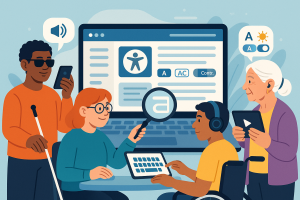Introduction
In today’s globalized world, diversity, equity and inclusivity have become essential components of creating a successful workplace. Creating a workplace culture that fosters these values helps attract and retain top talent, improves employee satisfaction and engagement, and ultimately drives business success.
However, even with the best intentions, individuals can harbor unconscious biases that can impact the workplace negatively. In this article, we will explore what unconscious bias is, how it affects the workplace, and provide practical strategies for mitigating these biases to create a more inclusive environment.
Unconscious Bias Definition
Unconscious bias refers to attitudes and beliefs that individuals hold, often unconsciously, that can lead to discrimination against certain groups. This bias can be based on factors such as race, gender, age, sexual orientation, religion or socio-economic status, and can impact how individuals perceive and interact with others in the workplace.
Types of Unconscious Bias in the Workplace
There are several types of unconscious bias that can impact the workplace, including:
1.Confirmation Bias: This is the tendency to seek and interpret information that confirms pre-existing beliefs and ignore information that contradicts them. In the workplace, confirmation bias can lead to assumptions about the capabilities or intentions of employees based on preconceived notions, rather than actual evidence.
Example: a manager who assumes that an older employee is not tech-savvy and less capable of learning new skills than a younger employee.
2.Stereotyping: This is when individuals assign attributes to groups based on limited information. In the workplace, stereotyping can lead to assumptions about an employee’s capabilities, work style, or cultural background based on their race, gender, age, or other factors.
Example: a person from North India may assume that their South Indian coworker is not fluent in Hindi, which can lead to a microaggression – such as “I didn’t know you could speak Hindi so well.”
3.Affinity Bias: This is the tendency to favor individuals or groups similar to oneself. In the workplace, affinity bias can lead to favoritism towards individuals who share similar backgrounds, interests, or personality traits.
Example: a hiring manager who is drawn to job candidates who attended the same college or university as they did.
4.Halo Effect: This is the tendency to form a positive impression of a person based on a single positive trait, such as attractiveness or likeability. In the workplace, the halo effect can lead to assumptions about an employee’s competence based on superficial factors.
Example: a manager who thinks that an employee who is always punctual and neatly dressed is also a high-performing employee without reviewing their actual work performance.
5.Attribution Bias: This is when individuals explain their own behavior based on external factors, while attributing the behavior of others to their internal traits. In the workplace, attribution bias can lead to assumptions about an employee’s performance based on factors beyond their control, such as the company’s resources or external market conditions.
Example: a team leader attributes the failure of a project to external factors such as budget constraints or market conditions, without taking responsibility for their own mistakes.
These biases can lead to preconceived notions and assumptions about an individual’s capabilities, work style or cultural background, and ultimately affect workplace relationships and decision-making. They can even make a workplace hostile.
Mitigating Unconscious Bias in the Workplace
To promote diversity and inclusivity in the workplace, it’s important to address unconscious bias. Here are some strategies to consider:
1.Implicit Bias Test: One of the first steps in addressing unconscious bias is to take an implicit bias test. This test can help individuals identify their unconscious biases and bring them to the surface. Several online tests are available for measuring implicit bias, including the well-known Implicit Association Test (IAT) developed by researchers at Harvard University. You can find the IAT here.
By recognizing their biases, individuals can take steps to address them and prevent them from negatively impacting their attitudes and behavior towards others.
2.Unconscious Bias Training: Unconscious Bias training typically includes a variety of educational materials, including workshops, videos, and other learning resources. These resources are designed to help employees understand the concept of unconscious bias, its impact on the workplace, and how to recognize and mitigate their own biases.
This type of training is not a one-time event, but rather an ongoing process. Companies may offer regular training sessions, incorporate unconscious bias education into existing training programs, and encourage employees to continue their own education on the topic.
3.Encourage Dialogue: It involves creating a safe and open environment where employees feel comfortable sharing their experiences and perspectives. It is essential to encourage open dialogue and feedback, and establish clear channels for communication.
4.Practice Inclusion: Actively practicing inclusivity means promoting a culture that values diversity and creates opportunities for all employees to thrive. This includes diversifying recruitment practices, creating diverse teams, and promoting equal opportunities for growth and advancement.
5.Implement Objective Criteria: Implementing objective criteria in hiring and promotion processes can help reduce the impact of personal preferences and biases. For example, use skills assessments or objective performance metrics to make decisions.
6.Hold Yourself and Others Accountable: Holding yourself and others accountable for promoting diversity and inclusivity in the workplace is critical. Establish clear standards for behavior, and take appropriate action when those standards are not met.
Conclusion
Unconscious bias can be a challenging issue to tackle, but it’s worth the effort to create a more inclusive and equitable workplace. By addressing unconscious biases, we can unlock the potential of our diverse teams and foster an environment where everyone can thrive.
Every individual has a unique perspective and brings valuable skills and experiences to the table. By embracing diversity and combating unconscious bias, we can create a workplace culture that not only benefits our teams but also drives business success.
Let’s commit ourselves to making a positive change and creating a workplace that truly reflects the world we live in.



